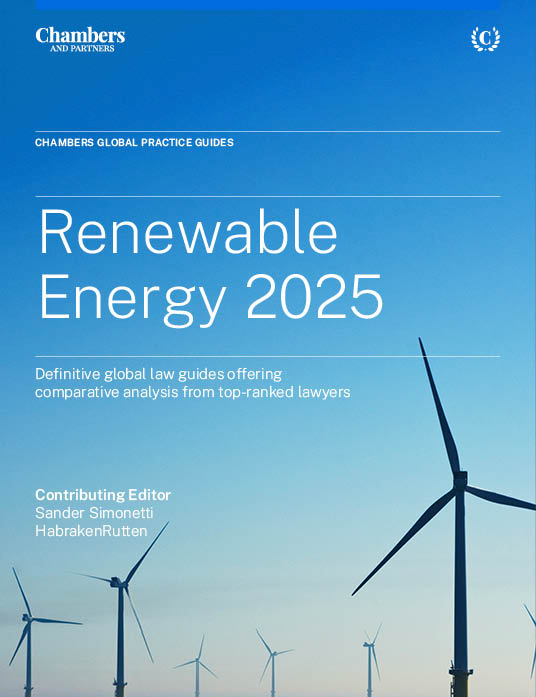
Renewable Energy 2025
The Renewable Energy 2025 guide features 17 jurisdictions. The guide provides the latest legal information on the energy transition and renewable energy technologies; the laws and regulatory authorities governing the energy sector; the generation, transportation and storage of electricity, gas (including hydrogen and biofuels) and heat; trade and supply; the financing, development and subsidisation of renewable energy projects; and the outlook for the sector.
Last Updated: September 25, 2025
Compare law and practice by selecting locations and topic(s)
Select Locations

Select Topic(s)

Please select at least one location and one topic to use the compare functionality.
Introduction
The global renewable energy sector continues its rapid expansion, entering 2025 with record-breaking deployment, investment and innovation. As nations accelerate their transition to sustainable energy systems, legal and regulatory frameworks are evolving at an unprecedented pace to govern, incentivise and integrate renewable energy across markets. The twin imperatives of combating climate change and achieving net-zero emissions by mid-century remain the primary drivers, while energy security, technological progress and economic opportunity reinforce the momentum.
Recent years have underscored the importance of resilient, diversified energy systems. The energy supply disruptions triggered by geopolitical tensions, including the ongoing repercussions of the war in Ukraine, have heightened awareness of the vulnerabilities of fossil fuel dependence. In parallel, extreme weather events, increasingly linked to climate change, are placing new demands on grid reliability and energy policy. Against this backdrop, renewable energy is no longer viewed solely as an environmental choice, but as a strategic and economic necessity.
Therefore, we are proud to present this second edition of the Chambers Renewable Energy Global Practice Guide. Following the very positive reception of the first edition last year, we are delighted to offer a fully updated volume that reflects the latest global trends, legal developments and market insights.
Global Commitments and Policies
International climate co-operation remains central to renewable energy policy. The Paris Agreement continues to guide national decarbonisation pathways, but the pace of ambition is accelerating. The 2023 UAE-hosted COP28 summit marked a historic political commitment to “transition away from fossil fuels” in energy systems, with countries agreeing to triple global renewable energy capacity by 2030. This has spurred a wave of updated national energy strategies, regulatory reforms and cross-border initiatives.
In the European Union, the “Fit for 55” package and REPowerEU plan are being actively implemented, with the EU already surpassing key interim renewable energy milestones in 2024. The United States, under the Inflation Reduction Act, should continue to deploy significant tax incentives for renewables, hydrogen and storage, while new grid modernisation programmes aim to ease transmission bottlenecks. However, the future trajectory of these incentives remains politically contingent. The current Trump administration’s critical stance on renewable energy could introduce uncertainty in the pace and consistency of implementation. In Asia, China remains the undisputed leader in renewable capacity additions, while India, Japan and South Korea are scaling up both utility-scale and distributed renewable projects, supported by evolving legal frameworks.
Decentralised action is also intensifying. Cities, regional governments and Indigenous-led initiatives are pursuing 100% renewable targets, community energy schemes and microgrid deployments, requiring tailored legal structures and governance models.
Innovations and Investments
Falling technology costs, particularly for solar PV, onshore wind and battery storage, continue to redefine market dynamics. Even with inflationary pressures and higher interest rates in 2024, global investment in renewables surpassed USD600 billion, according to preliminary figures from the International Energy Agency. While solar and wind remain dominant, green hydrogen, floating offshore wind, sustainable aviation fuels and long-duration storage technologies are attracting growing capital.
The legal landscape is adapting to accommodate new financing structures, corporate power purchase agreements (PPAs) and merchant market projects. Institutional investors and sovereign funds are expanding their renewable portfolios, often accompanied by due diligence requirements on supply chain sustainability, biodiversity impacts and human rights compliance.
Employment in the sector reached approximately 15 million jobs in 2024, with strong growth in project development, legal and regulatory compliance and environmental assessment. Corporate commitments, led by major technology, manufacturing and retail brands, are continuing to drive demand for renewable power, influencing not only energy markets but also contract law and energy regulation.
Wind Energy
Wind power remains a cornerstone of the renewable energy mix. Onshore wind continues to be among the lowest-cost generation options, though land-use, permitting and community engagement challenges persist. Offshore wind, meanwhile, has entered a new growth phase, with significant capacity auctions held in 2024 across Europe, the US and Asia-Pacific.
Floating offshore wind, now moving from demonstration to commercial scale, is unlocking development potential in deeper waters, with complex maritime, environmental and grid-connection regulatory issues coming to the fore. Competitive tender processes increasingly integrate non-price criteria such as biodiversity protection, supply chain localisation and coexistence with fisheries.
Solar Power
Solar PV remains the fastest-growing renewable energy technology worldwide, with global installed capacity exceeding 1.6 terawatts in 2024. Both utility-scale and distributed generation are expanding rapidly, supported by favourable policy environments, innovative leasing and financing models, as well as integration with energy storage.
Emerging economies are playing a central role in this growth. In Africa, South Asia and Latin America, off-grid and mini-grid solar, often coupled with batteries, is advancing rural electrification, supported by donor-backed legal frameworks and public–private partnerships.
Other Renewable Technologies
Beyond wind and solar, other renewable technologies are gaining regulatory and investment traction:
- Sustainable Heat: District heating systems using geothermal, biomass or waste heat are expanding, with new regulations on consumer protection, emissions standards and pricing transparency.
- Biofuels: Sustainable aviation fuel mandates and maritime decarbonisation regulations are stimulating biofuel demand. Legal frameworks now increasingly address feedstock certification and lifecycle emissions accounting.
- Hydrogen: The global hydrogen economy advanced significantly in 2024, with early-stage green hydrogen hubs beginning commercial operation. Regulatory efforts are focusing on infrastructure standards, market rules and certification schemes to ensure “green” credibility.
Grid Integration and Energy Storage
Grid congestion, permitting delays and interconnection queues remain critical challenges for renewable energy deployment. Governments and regulators are responding with targeted reforms, streamlining permitting, expanding grid capacity and enabling advanced demand-response programmes.
Battery storage installations surged in 2024, both at utility scale and behind-the-meter. Legal and regulatory frameworks are adapting to address storage participation in electricity markets, revenue stacking and safety standards. Meanwhile, hydrogen-to-power, pumped hydro and thermal storage are emerging as complementary solutions for seasonal balancing.
Smart grid development is increasingly linked to cybersecurity regulation, data governance and consumer privacy, as digitalisation reshapes electricity market operations.
Conclusion
As of 2025, renewable energy is no longer a niche sector: it is the central pillar of future energy systems. The convergence of technological innovation, supportive regulation and strong political will is reshaping global energy markets and creating new legal and commercial realities.
However, the transition remains complex. Intermittency, infrastructure bottlenecks, supply chain constraints and the need for just and equitable transition policies present ongoing challenges. Legal practitioners, regulators and policymakers must navigate a rapidly evolving landscape that spans domestic statutes, cross-border agreements and emerging international norms.
This 2025 edition of the Chambers Global Practice Guide provides a jurisdiction-by-jurisdiction overview of the law and regulation shaping renewable energy projects, production and supply worldwide, alongside insights into current trends, market developments and future outlooks. Our aim remains to equip practitioners with the knowledge needed to operate in one of the most dynamic and impactful sectors of the global economy.


